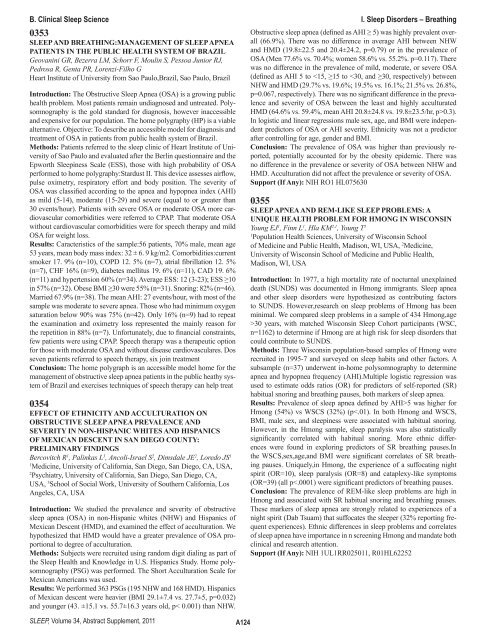SLEEP 2011 Abstract Supplement
SLEEP 2011 Abstract Supplement
SLEEP 2011 Abstract Supplement
Create successful ePaper yourself
Turn your PDF publications into a flip-book with our unique Google optimized e-Paper software.
B. Clinical Sleep Science I. Sleep Disorders – Breathing<br />
0353<br />
<strong>SLEEP</strong> AND BREATHING:MANAGEMENT OF <strong>SLEEP</strong> APNEA<br />
PATIENTS IN THE PUBLIC HEALTH SYSTEM OF BRAZIL<br />
Geovanini GR, Bezerra LM, Schorr F, Moulin S, Pessoa Junior RJ,<br />
Pedrosa R, Genta PR, Lorenzi-Filho G<br />
Heart Institute of University from Sao Paulo,Brazil, Sao Paulo, Brazil<br />
Introduction: The Obstructive Sleep Apnea (OSA) is a growing public<br />
health problem. Most patients remain undiagnosed and untreated. Polysomnography<br />
is the gold standard for diagnosis, however inaccessible<br />
and expensive for our population. The home polygraphy (HP) is a viable<br />
alternative. Objective: To describe an accessible model for diagnosis and<br />
treatment of OSA in patients from public health system of Brazil.<br />
Methods: Patients referred to the sleep clinic of Heart Institute of University<br />
of Sao Paulo and evaluated after the Berlin questionnaire and the<br />
Epworth Sleepiness Scale (ESS), those with high probability of OSA<br />
performed to home polygraphy:Stardust II. This device assesses airflow,<br />
pulse oximetry, respiratory effort and body position. The severity of<br />
OSA was classified according to the apnea and hypopnea index (AHI)<br />
as mild (5-14), moderate (15-29) and severe (equal to or greater than<br />
30 events/hour). Patients with severe OSA or moderate OSA more cardiovascular<br />
comorbidities were referred to CPAP. That moderate OSA<br />
without cardiovascular comorbidities were for speech therapy and mild<br />
OSA for weight loss.<br />
Results: Caracteristics of the sample:56 patients, 70% male, mean age<br />
53 years, mean body mass index: 32 ± 6. 9 kg/m2. Comorbidities:current<br />
smoker 17. 9% (n=10), COPD 12. 5% (n=7), atrial fibrillation 12. 5%<br />
(n=7), CHF 16% (n=9), diabetes mellitus 19. 6% (n=11), CAD 19. 6%<br />
(n=11) and hypertension 60% (n=34). Average ESS: 12 (3-23); ESS ≥10<br />
in 57% (n=32). Obese BMI ≥30 were 55% (n=31). Snoring: 82% (n=46).<br />
Married 67.9% (n=38). The mean AHI: 27 events/hour, with most of the<br />
sample was moderate to severe apnea. Those who had minimum oxygen<br />
saturation below 90% was 75% (n=42). Only 16% (n=9) had to repeat<br />
the examination and oximetry loss represented the mainly reason for<br />
the repetition in 88% (n=7). Unfortunately, due to financial constraints,<br />
few patients were using CPAP. Speech therapy was a therapeutic option<br />
for those with moderate OSA and without disease cardiovasculares. Dos<br />
seven patients referred to speech therapy, six join treatment<br />
Conclusion: The home polygraph is an accessible model home for the<br />
management of obstructive sleep apnea patients in the public heathy system<br />
of Brazil and exercises techniques of speech therapy can help treat<br />
0354<br />
EFFECT OF ETHNICITY AND ACCULTURATION ON<br />
OBSTRUCTIVE <strong>SLEEP</strong> APNEA PREVALENCE AND<br />
SEVERITY IN NON-HISPANIC WHITES AND HISPANICS<br />
OF MEXICAN DESCENT IN SAN DIEGO COUNTY:<br />
PRELIMINARY FINDINGS<br />
Bercovitch R 1 , Palinkas L 3 , Ancoli-Israel S 2 , Dimsdale JE 2 , Loredo JS 1<br />
1<br />
Medicine, University of California, San Diego, San Diego, CA, USA,<br />
2<br />
Psychiatry, University of California, San Diego, San Diego, CA,<br />
USA, 3 School of Social Work, University of Southern California, Los<br />
Angeles, CA, USA<br />
Introduction: We studied the prevalence and severity of obstructive<br />
sleep apnea (OSA) in non-Hispanic whites (NHW) and Hispanics of<br />
Mexican Descent (HMD), and examined the effect of acculturation. We<br />
hypothesized that HMD would have a greater prevalence of OSA proportional<br />
to degree of acculturation.<br />
Methods: Subjects were recruited using random digit dialing as part of<br />
the Sleep Health and Knowledge in U.S. Hispanics Study. Home polysomnography<br />
(PSG) was performed. The Short Acculturation Scale for<br />
Mexican Americans was used.<br />
Results: We performed 363 PSGs (195 NHW and 168 HMD). Hispanics<br />
of Mexican descent were heavier (BMI 29.1±7.4 vs. 27.7±5, p=0.032)<br />
and younger (43. ±15.1 vs. 55.7±16.3 years old, p< 0.001) than NHW.<br />
Obstructive sleep apnea (defined as AHI ≥ 5) was highly prevalent overall<br />
(66.9%). There was no difference in average AHI between NHW<br />
and HMD (19.8±22.5 and 20.4±24.2, p=0.79) or in the prevalence of<br />
OSA (Men 77.6% vs. 70.4%; women 58.6% vs. 55.2%. p=0.117). There<br />
was no difference in the prevalence of mild, moderate, or severe OSA<br />
(defined as AHI 5 to 30 years, with matched Wisconsin Sleep Cohort participants (WSC,<br />
n=1162) to determine if Hmong are at high risk for sleep disorders that<br />
could contribute to SUNDS.<br />
Methods: Three Wisconsin population-based samples of Hmong were<br />
recruited in 1995-7 and surveyed on sleep habits and other factors. A<br />
subsample (n=37) underwent in-home polysomnography to determine<br />
apnea and hypopnea frequency (AHI).Multiple logistic regression was<br />
used to estimate odds ratios (OR) for predictors of self-reported (SR)<br />
habitual snoring and breathing pauses, both markers of sleep apnea.<br />
Results: Prevalence of sleep apnea defined by AHI>5 was higher for<br />
Hmong (54%) vs WSCS (32%) (p

















